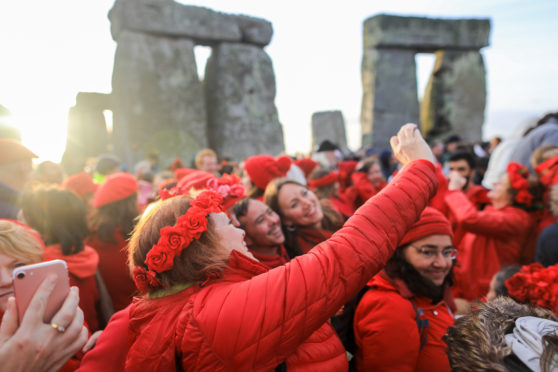
A smiley souvenir snap or a narcissistic blight on our most historic attractions?
A chaplain to the Queen has criticised people taking selfies using churches and other historic monuments as backdrops., former Moderator of the General Assembly of the Church of Scotland, said the selfie culture was “narcissism gone wild.”
Writing in the Kirk’s house magazine, Life And Work, Dr Chalmers said that last summer he and his wife visited the Pantheon, “one of Rome’s most extraordinary buildings.”
“The experience was breathtaking. We wondered how ancient architects, engineers and builders managed to create such an awe-inspiring space and we wondered how many lives of how many slaves might have been lost during construction?” said Dr Chalmers. “Still almost speechless, we spilled out into the daylight alongside others from around the world who were also enjoying the amazing sites of the city.
“That was when we overheard a young man say to his companion, ‘Where do you want to go now?’ The response, quick as a flash, was simple. ‘Let’s nip down to the Vatican, I don’t want to hang around there, but I need to get a quick selfie in front of St Peter’s, then we’re done.
“If taking in the scale and precision of the Pantheon had been a staggering experience, so also was this short snippet of overheard conversation.
“Here was the prospect of visiting a UNESCO World Heritage Site with its unique collection of artistic and architectural masterpieces and what seemed to be more important than anything was capturing a selfie that reduces the surrounding scene to no more than a backdrop.
“We thought about those showground photo-booths and wondered what it was about human nature that draws our eye away from the wider horizon and tempts us into being at the centre of every picture. What does today’s obsession with taking selfies tell us about the human condition?
“It’s not that I want people to visit ancient monuments or stand in front of lavish palaces or places of worship with an uncritical eye.
“By all means take in the sights and ask why – why has so much money been spent on follies for the amusement of the rich at the expense of the poor? Why is our church history blighted by projects that have been more about the glory of church leaders than the glory of God?
“Ask the moral questions; plumb the depths of history but, for any favour, don’t just use these places as a canvas for the latest picture of me as the sun around which everything else orbits.
Dr Chalmers went on to describe selfie culture as “narcissism gone wild”. He wrote: “There may be nothing much wrong with the occasional photo that shows us standing beside some famous person or site, but is it altogether healthy to be running around with your phone on the end of a selfie-stick to make sure you are at the centre of every picture?
“Narcissism is a word derived from Greek mythology, where the young hunter Narcissus falls in love with his own image ref. My late mother was no psychoanalyst, but she could spot an over-inflated ego at a hundred yards and would say of those who had an overblown sense of importance: ‘I wonder how their last trumpeter died?’
“I don’t think Carly Simon named the lover of whom she sang, ‘You’re so vain, you probably think this song is about you’, but we all know the kind of personality that was getting under her skin. Life isn’t about me, me, me! Modesty beats pride, hands down, humility is healthier than arrogance and self-effacement beats self-importance.
“In John’s Gospel, when John the Baptist recognises the person of Jesus in the midst he realises it was the time for Jesus to move into the centre, while he slipped to the sidelines.
“As we try to revitalise the Church of Scotland it would be good to remember that centre stage belongs to the Carpenter who said (Luke 9:23) that following Him was about self-denial and it was about taking up a cross rather than a selfie stick.”
Last year VisitScotland revealed Scotland’s tourism boom was partly down to travellers in their teens and 20s taking more mini-breaks to see popular selfie sights such as Dunnottar Castle in Aberdeenshire and Eilean Donan Castle in Ross-shire.

Enjoy the convenience of having The Sunday Post delivered as a digital ePaper straight to your smartphone, tablet or computer.
Subscribe for only £5.49 a month and enjoy all the benefits of the printed paper as a digital replica.
Subscribe